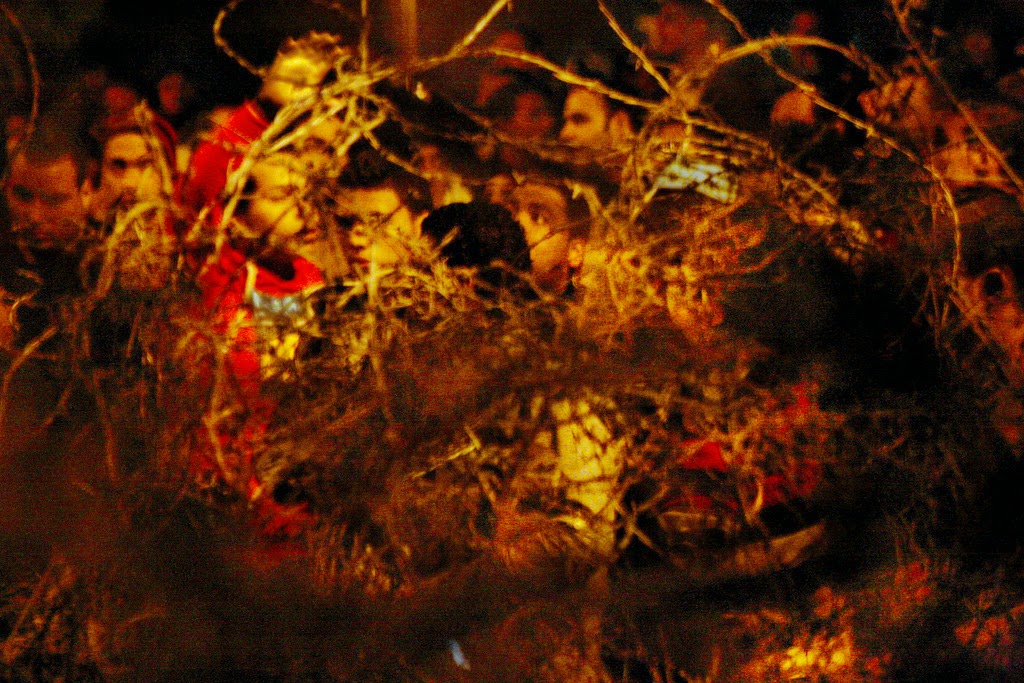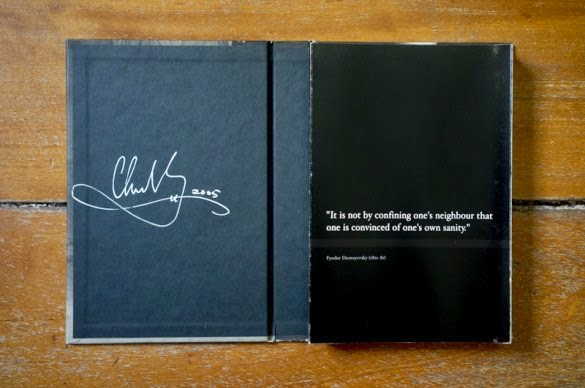WESSING, KOEN - Momentopname Suid-Afrika - Flashes from South-Africa
Amsterdam, Fragment Utgeverij, 1993. First edition. Softcover. 32 x 24. Only publication of Wessing's South Africa travels; this book documents South Africa reeling between hope and fear after Nelson Mandela's release in 1990.
8 juli 2000
In het gebouw waar ik werk, de voormalige Grote Club in Amsterdam, zijn ook enkele effectenkantoren gevestigd. Het is vlakbij de Beurs. Ik sta na werktijd in de lift met een dertiger, in een gewichtig duur pak, opzichtig nonchalant gekapt, gsm aan het oor, op en top beursbengel. Beneden gekomen wil ik de buitendeur openen en hem langslaten, maar druk pratend in zijn telefoon knalt hij me opzij. De deur zwiept in mijn gezicht dicht.
Het verwonderende in deze momentopname is, hou me ten goede, niet het gebrek aan beleefdheid van de jonge carrièremaker, want dat interesseert me niet zo. Wat me verontrust is iets verstrekkenders: de hier gedemonstreerde fixatie van iemand op zichzelf en op het eigen succes. Misschien is weinig in het dagelijkse leven zo kenmerkend voor een tijd waarin 'gemeenschapsgevoel' uitsluitend beleefd lijkt te kunnen worden in de vorm van hossen met oranje petjes op. Het is een uiting van zelfgenoegzaamheid die gelijk op gaat met onverschilligheid jegens de rest van de wereld.
Ik was op weg naar het Amsterdams Historisch Museum waar dinsdag een overzichtstentoonstelling werd geopend van de fotograaf Koen Wessing, De wereld van Koen Wessing, een angstaanjagende, zwart-witwereld vol paupers, slachtoffers, vluchtelingen, verworpenen, overlevers. H.J.A. Hofland hield een strenge redevoering tegen de onverschilligheid en zelfvoldaanheid, de andere wereld, waar ik zojuist nog even een glimp van had opgevangen.
,,Kijkend naar deze foto's'', zei Hofland, ,,dacht ik telkens weer: wat is er met ons gebeurd?'' Waarna hij sprak over nieuwe economie, nieuwe vraatzucht, informatica, bomen die in de hemel groeien, een schizofrene beschaving, een van zichzelf vervuld geraakte samenleving.
Jeremia! Dat was geen vrolijk verhaal. Het zijn dan ook uitgesproken politieke foto's die Koen Wessing in de loop van veertig jaar, trouw aan zichzelf, heeft gemaakt. Wessing grijpt ons - wat is er met ons gebeurd? - bij de lurven. Hardhandig. Zijn omzwervingen zijn die van een opgejaagde. Hij fotografeerde in alle uithoeken van de aarde geknechte mensen die hun waardigheid tegen de klippen op overeind proberen te houden. Chili, Midden-Amerika, Zuid-Afrika, China, Tibet, Kosovo, om een greep te doen.
Met pamflettisme heeft het niets te maken. Het etiket 'sociale fotografie' (waarmee de schitterende Nederlandse documentaire fototraditie van Eva Besnyö, Cas Oorthuys, Ad Windig, Emmy Andriesse, Carel Blaazer, Dolf Kruger, Ed van der Elsken, Ad van Denderen, Willem Diepraam, Dolf Toussaint, Kadir van Lohuizen, enz. veelal laatdunkend wordt afgedaan) is niet toereikend. En het verwijt dat geëngageerde fotografie al snel leidt tot vermoeidheid bij de kijker (,,Op den duur gaan alle slachtoffers op elkaar lijken'', schreef Max van Rooy ooit over Wessing) wordt door deze tentoonstelling weerlegd.
Wel dwingen Wessings foto's de kijker tot een moreel oordeel. Het is onmogelijk dit werk op zijn artistieke waarde te schatten - als universeel geldige uitbeelding van het lot van de mens - zonder de bereidheid zich te verplaatsen in de ander. Wessing moet je vergelijken met Goya. Wie haalt het in zijn hoofd Goya's Desastres de la Guerra primair te beschouwen als werk van een achterhaalde wereldverbeteraar, agitprop-artiest of etsende zendeling? ,,Wat Wessing gemaakt heeft'', schrijft Melchior de Wolff in Vrij Nederland, ,,is een persoonlijke inspectie van de werkelijkheid, die zich blijvend in de geheugens van het publiek heeft vastgezet.'' Blijvend, dat is hier het sleutelwoord. Blijvend vastgezet: ik kan niet denken aan Chili 1973 zonder de foto voor mijn geestesoog te zien die Wessing maakte van een straatrazzia in Santiago. Beklemmend is daar een te zwakke kwalificatie voor. Zoals Hofland het in zijn openingstoespraak omschreef: ,,Daar wordt de angst voor de uitzichtloze gevangenschap van de dictatuur zichtbaar, de staalsmaak van de terreur. Het zijn niet meer je hersens, het is je maag waarmee je de blindheid van het meedogenloze herkent.''
Toch doet het Koen Wessing onvoldoende recht in hem alleen of zelfs maar voornamelijk de maker van deze foto te zien, zoals Robert Capa niet alleen maar die beroemde foto heeft gemaakt van de vallende soldaat in de Spaanse burgeroorlog. Wessing is niet de man van één of enkele foto's, zijn medium is de reportage en de reportageseries schakelen zich aaneen tot een samenhangend oeuvre en tot een wereldbeeld.
Het is verbazingwekkend hoe de samensteller van de tentoonstelling, de Amsterdamse ontwerper Jeroen de Vries, erin is geslaagd de essentie van een zo omvangrijk levenswerk in een kleine ruimte tot zijn recht te laten komen. Ook dat is betrokkenheid, het tegendeel van onverschilligheid. De expositie is zo ingericht, dat men de fotografische kwaliteit van het werk van Wessing kan afmeten aan het gedeelte met een opstelling van honderd grote afdrukken, terwijl je het verhalende karakter en de politieke lading ervan voluit ervaart in een arena van projectieschermen, waar honderden dia's in epoche-omspannende reportages voorbij flitsen. Vechtend tegen een verraderlijke vorm van nostalgie, zag ik mijn eigen tijd en de voedingsbronnen van mijn verontwaardiging en betrokkenheid voorbij komen. ,,Wat is er met ons gebeurd?''
Melchior de Wolff vraagt zich in zijn recensie in Vrij Nederland nijdig af waarom de opening van deze tentoonstelling niet verricht werd door Wim Kok. ,,In wat voor een slaperige politieke cultuur is het land eigenlijk terechtgekomen?'' Een gerechtvaardigde vraag, maar tegelijkertijd is het ook een symptoom van slaperige politieke cultuur om bij het begrip 'politiek' bijna reflexmatig te denken aan politici, aan een minister-president, burgemeesters, parlementsleden, departementen, deelraadvoorzitters. De fotografie van Koen Wessing is al sinds de jaren zestig (Parijse Mei-revolte, bezetting van het Maagdenhuis) ronduit partijdig, maar nooit in partijpolitieke zin en al zeker niet in de zin van enigerlei identificatie met bestuurders en ambtsdragers.
Maar De Wolff heeft gelijk dat het belang van tentoonstellingen als deze moeilijk kan worden overschat. Ik vond de opening als nieuwsfeit meer de moeite waard dan de overname door VNU van Ilse. Maar hoe vertel ik dat aan die beursman in de lift?
 once commented succinctly on his work as follows: 'They get what they ask for, but I deliver damn good work' - the very thing that makes industrial photography books so attractive. The books show work from a period during which photographers could not make a living as artists/photographers and depended on such prestigious commissions. With this highly professional approach, photographers like Violette Cornelius Violette Cornelius and Ata Kando: Hungarian Refugees 1956
once commented succinctly on his work as follows: 'They get what they ask for, but I deliver damn good work' - the very thing that makes industrial photography books so attractive. The books show work from a period during which photographers could not make a living as artists/photographers and depended on such prestigious commissions. With this highly professional approach, photographers like Violette Cornelius Violette Cornelius and Ata Kando: Hungarian Refugees 1956 , Cas Oorthuys 75 Jaar Bouwen, Van ambacht tot industrie 1889-1964
, Cas Oorthuys 75 Jaar Bouwen, Van ambacht tot industrie 1889-1964 , Ed van der Elsken , Ad Windig Het water - Schoonheid van ons land
, Ed van der Elsken , Ad Windig Het water - Schoonheid van ons land and Paul Huf established their reputations and influenced our present-day impression of workers and entrepreneurs in the postwar Netherlands. Experimental poets and well-known writers also contributed to these books, fifty of which are on show. 'Het bedrijfsfotoboek 1945-1965. Professionalisering van fotografen in het moderne Nederland' Het Bedrijfsfotoboek 1945-1965
and Paul Huf established their reputations and influenced our present-day impression of workers and entrepreneurs in the postwar Netherlands. Experimental poets and well-known writers also contributed to these books, fifty of which are on show. 'Het bedrijfsfotoboek 1945-1965. Professionalisering van fotografen in het moderne Nederland' Het Bedrijfsfotoboek 1945-1965 .
. 

.jpg)




























































